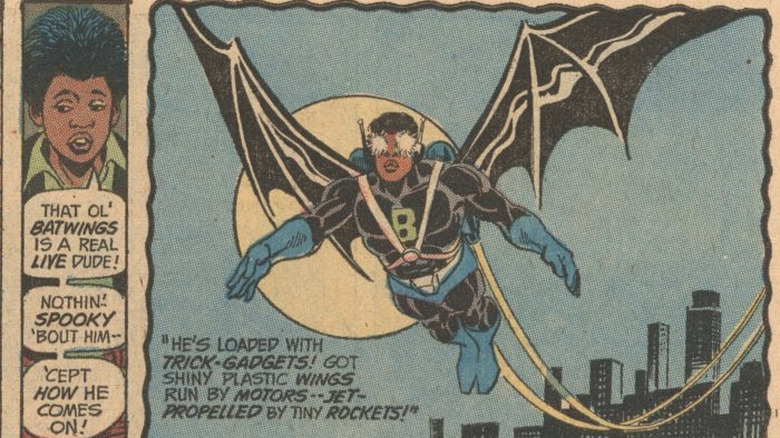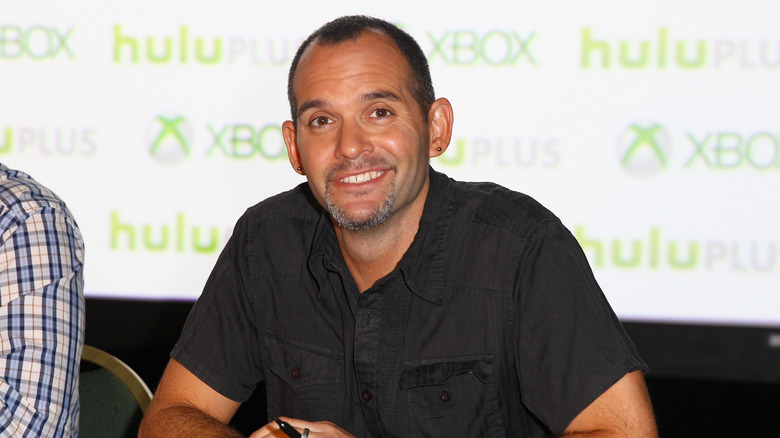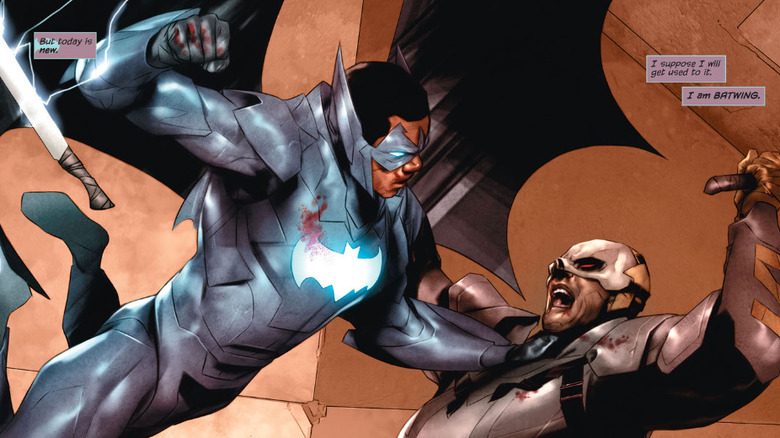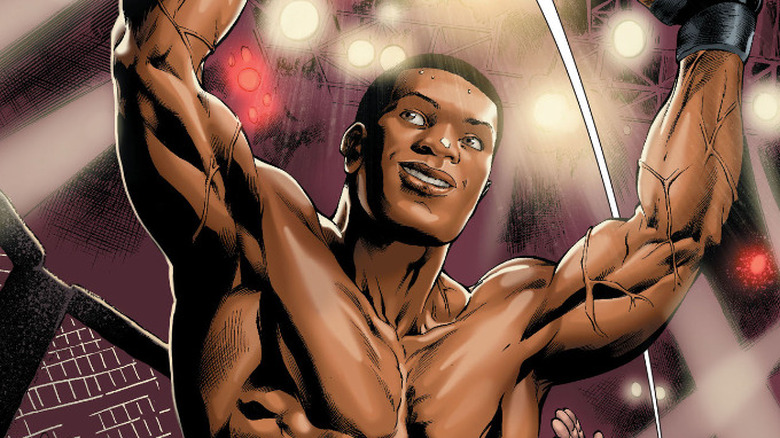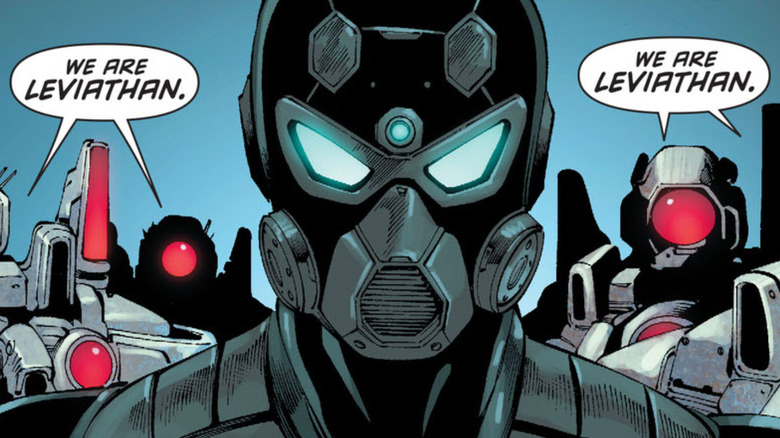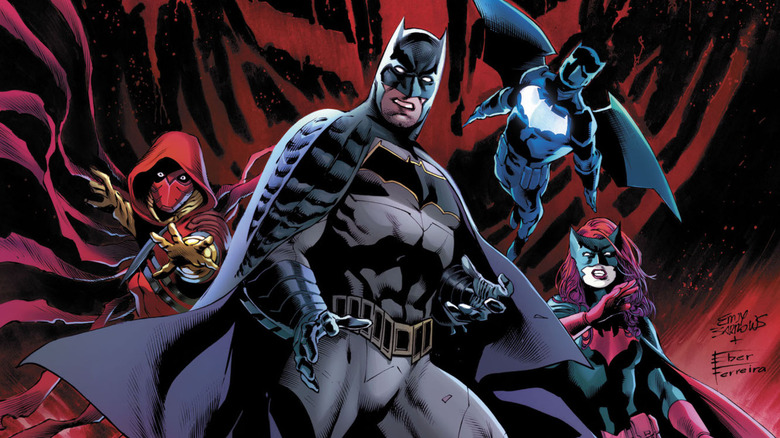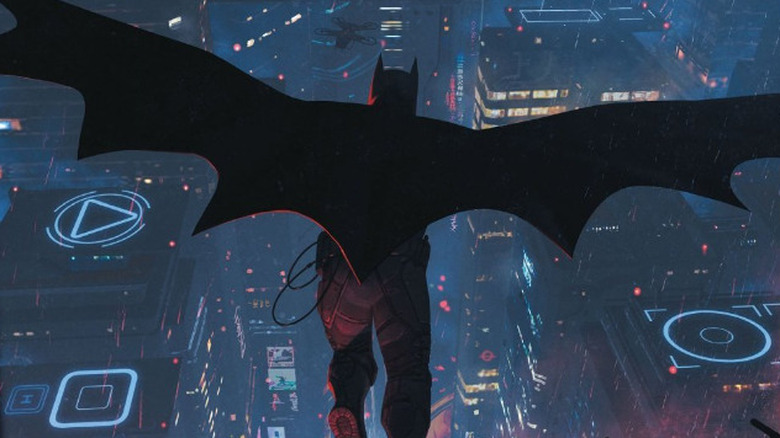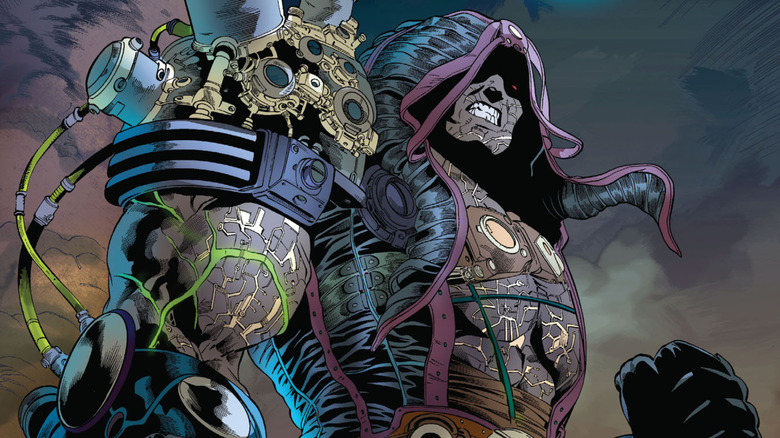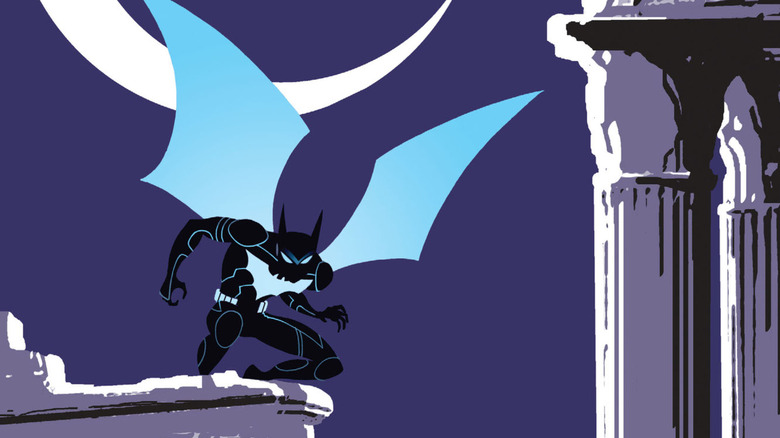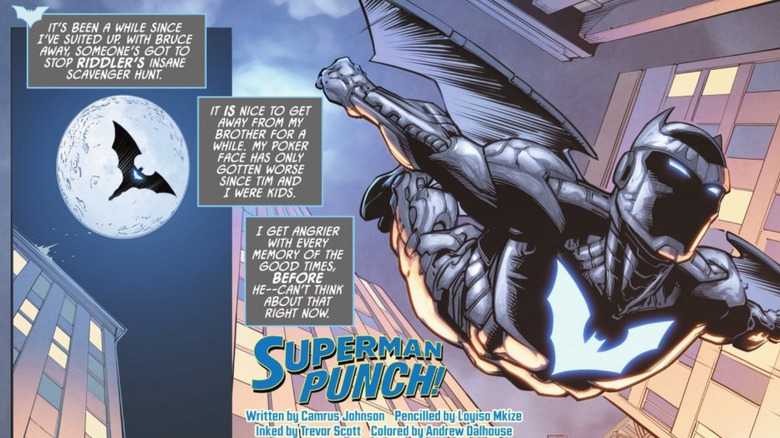The Untold Truth Of Batwing
A new hero is on the horizon in the DC Extended Universe, and his coming has been long awaited. Camrus Johnson has been playing Luke Fox on the CW's "Batwoman" for almost two seasons, and while the character Johnson portrays isn't entirely similar to the Luke Fox of the comic books, fans have long speculated that he would eventually put on a bat-suit of his own and fight crime alongside the titular protagonist. When an alternate version of Fox appeared in the 2019 "Crisis on Infinite Earths" crossover storyline and seemed to drop some clues about a former life as a superhero, that speculation ramped up considerably. And on June 8, with Season 2 of "Batwoman" rapidly approaching its finale, Johnson took to Twitter and made it official: Batwing is coming to the Arrowverse.
Of course, if you're not a reader of modern DC Comics, you'd be forgiven for not knowing who Batwing is. The character has an interesting history, but not a long one — at least, not in comic book years. He's only been around for a decade, and the "Batwing" ongoing series only lasted 34 issues before being canceled in 2014. Fortunately, we're here to catch you up on all things Batwing, because the last thing you want when Johnson straps a glowing blue bat symbol to his chest and soars out into the increasingly crowded skies of Gotham City is to be left in the dark!
The Batman nobody knows
Batwing didn't appear in DC Comics until 2011, but his origins actually date back to 1973, when DC published "Batman #250." Comics of the era often featured a primary story, which took up most of the issue, followed by one or two secondary stories — usually short, standalone tales centering minor characters. "The Batman Nobody Knows" (later adapted for "Batman: The Animated Series") was one of these, a six-pager at the end of "Batman" #250 in which three young boys, out on a camping trip with Bruce Wayne, discuss their personal images of Batman. One of the boys, Ronnie, is Black, and describes his version of Batman as "Muhammad Ali — Jim Brown — Shaft — an' Super-Fly all rolled into one!" Ronnie also refers to Batman as "ol' Batwings."
While Ronnie's Batman exists only in his own mind, the seeds planted in this issue would bear fruit 40 years later, when writer Grant Morrison and artist Chris Burnham began work on a comic called "Batman Incorporated." In this storyline, Batman seeks to widen the scope of his war on crime by essentially setting up Batman franchises all over the world, supplying tools and technology to aspiring young heroes in other countries. One of these is the Congolese David Zavimbe, introduced in "Batman Incorporated" #5, whose costume bears a striking resemblance to the one from Ronnie's imagination — indeed, Morrison and Burnham took their inspiration directly from "The Batman Nobody Knows." From that idea, Batwing was born.
A Judd Winick joint
David Zavimbe didn't have a whole lot to do in the original run of "Batman Incorporated," but things changed a few months later, when DC canceled its entire line of superhero comics and relaunched with 52 new ongoing series, all branded under the name "The New 52." While many of these were simply new versions of titles that had previously existed, some of them were comics that had never been seen before, and among that number was "Batwing," which published its first issue in September 2011. The series featured Zavimbe as the main character and was written by Judd Winick, who was also penning the New 52 "Catwoman" series.
Winick's unorthodox career has enough twists and turns that it could be the subject of its own "untold truth" article. Originally a comic strip cartoonist, he gained fame in 1994 as a cast member on the reality TV show "The Real World: San Francisco," where he would meet his future wife, Pam Ling, and where he would become close friends with AIDS educator Pedro Zamora. After Zamora died of the disease, Winick wrote the award-winning graphic novel "Pedro and Me," and shortly thereafter started working for DC Comics, writing stories about Batman, Green Arrow, Green Lantern, and Captain Marvel, among others, before being tapped for "The New 52." As you'll see, it's impossible to separate Winick's creative influence from the first Batwing, despite the fact that neither Winick nor Zavimbe would be long for DC.
The Batman of Africa
Judd Winick's friendship with Pedro Zamora changed his life in massive and fundamental ways, and he continued Zamora's work in AIDS education after the latter's death. Most notable for comic book fans, however, is the fact that upon arriving at DC, Winick immediately began using some of the world's most prominent superheroes to explore themes of homosexuality and AIDS, creating the gay supporting cast member Terry Berg for "Green Lantern" and making Green Arrow's sidekick, Speedy, the most mainstream HIV-positive comic book hero in history (Thea Queen, Green Arrow's sister and sidekick in "Arrow," is loosely based on this version of the character). It only makes sense that Winick's first act when fleshing out David Zavimbe in the pages of "Batwing" would be to make him an AIDS orphan, the child of parents who had both been taken by the disease, a common occurrence in Africa.
That isn't the only explicitly African theme Winick brought to the table in "Batwing," a comic that was set primarily in the Democratic Republic of the Congo. Zavimbe battles not only corruption in the police force in which he works, but also the threat of rampaging warlords who use children as soldiers, reminiscent of the all-too-real Lord's Resistance Army — Zavimbe is a former child soldier himself. The result is that the book feels distinctly and realistically African, although, in the words of South African journalist Sipho Hlongwane, "As much as we have super villains, we don't do super heroes here."
Luke Fox takes up the mantle
Winick left DC in 2012, with his last issue of "Batwing" coming out in November. The next four issues were written by legendary ex-Marvel scribe Fabian Nicieza, but in April 2013, those duties were assumed by Jimmy Palmiotti and Justin Gray. Palmiotti was best known at the time for his partnership with Joe Quesada — the two co-created Event Comics and some of its most popular characters, like Painkiller Jane, as well as the imprint Marvel Knights. Palmiotti would later gain acclaim, alongside his wife, Amanda Conner, for their celebrated run on the "Harley Quinn" series that would redefine the character and provide the basis for the version seen in films like "Suicide Squad" and "Birds of Prey."
Palmiotti is also responsible for the creation of Luke Fox — MIT graduate, cage fighter, son of Lucius Fox, and the second Batwing — who first appears in "Batwing" #19. The majority of that issue deals with David Zavimbe's decision to stop being Batwing, breaking the news to Batman in words that echo those of Hlongwane: "It doesn't work everywhere. The methods, the symbol, it doesn't mean the same thing here." And Palmiotti wastes little time in moving the book's setting out of Africa, returning Fox to Gotham (where the methods do work, presumably) after a few issues of loose-end-tying. Luke Fox has been Batwing ever since, and while the contributions of Morrison and Winick were pivotal, Palmiotti is the true father of the character as we know him today.
Leviathan brings Batwing full circle
Palmiotti's run, and the "Batwing" ongoing series in general, ended in August 2014 with "Batwing" #34, though at no point in that issue does Luke Fox decide to give up being Batwing. Despite his solo comic ending, Fox would continue to be a fixture of the DC superhero universe — though perhaps with fewer overall appearances than fans might have hoped for. Before he was completely finished, however, Palmiotti had one last Batwing story to write — a story that calls back to the character's very first official appearance.
The primary villain of Grant Morrison's "Batman Incorporated" series, in which Batwing was introduced, was a shadowy organization called Leviathan, whose true nature isn't revealed until the final issue (and which was adapted for the Arrowverse's "Supergirl" series). Palmiotti tips a hat to Morrison in his "Batwing" swan song, a one-shot installment of the crossover series "Future's End," which explores the future of the New 52. In the issue, it appears that Batwing himself is behind a future version of Leviathan, and is leading it so effectively that other crime syndicates are going out of business. The mysterious Corvid Corax gathers the leaders of the syndicates for an assault on Leviathan ... but they realize, too late, that it's a trap. Corax is actually a disguised Batwing, who has been playing them the whole time. Leviathan isn't real, merely the cover for an intricate sting operation, and the criminal leaders are quickly dispatched by the full roster of Batman Incorporated.
He's a Gotham City regular
While never again a title character, Luke Fox has ended up in some very interesting stories in the last seven years. His first major appearance post-"Batwing" came in the 2014-2015 limited series "Batman Eternal," which was created to celebrate Batman's 75th anniversary as a character. The series involved five different writers who each focused on a specific genre and set of characters related to Batman's history; Ray Fawkes' genre was horror, and his part of the story centered around Batwing and Gotham City police detective Jim Corrigan, aka the Spectre. "Batman Eternal" also re-introduced the character of Alfred's daughter, Julia Pennyworth, who hadn't been seen in comics since the 1980s — and who is portrayed by Christina Wolfe in "Batwoman." Shortly after the end of "Batman Eternal," Luke showed up again in the pages of "Batgirl" as the romantic interest of the New 52's Barbara Gordon.
After DC continuity was rebooted again in 2016 via the event known as "DC Rebirth," Batwing spent two years being featured in the pages of "Detective Comics" as written by James Tynion IV, who had also been a major contributor to "Batman Eternal." Tynion's run saw Batwing once again become part of a team of Bat-related characters under Batman's direction, which included Red Robin, Spoiler, Clayface, Orphan, and Azrael. It also included Kate Kane in her role as Batwoman, forging the first comic book connection between Luke Fox and the character played by Ruby Rose in "Batwoman's" debut season.
He might be Batman's brother
Batwing hasn't been featured much in the most recent publications of DC Comics, but to be fair, at least this time there's a decent reason: He's been leapfrogged in importance by his brother. The idea that Lucius Fox had a troubled son named Timothy goes back to 1979 — in fact, most of Luke's family predates him in terms of DC publication history by several decades. Unlike Luke, however, Tim had never been used as a major character until he was reintroduced in 2021. And when we say "major character," we're not being hyperbolic. In 2021, Tim Fox is Batman. Or at least, he might be.
DC's early 2021 event "Future State" took place in a potential future version of the DC universe billed as "a glimpse into futures both near and far," though what that exactly means is unclear. What is clear is that in the world of "Future State," Tim Fox has taken over for Bruce Wayne as Batman, and "The Next Batman," penned by John Ridley, was one of the highlights of the event. More recently, DC has kicked the tires on a digital series called "The Next Batman: Second Son," which chronicles the series of events that led to Tim becoming Batman, and in which Luke plays a fairly major role as Tim's estranged brother. But of course, we won't know if Tim as Batman will stick until DC is finished with "Infinite Frontier," yet another reorganization of its hopelessly tangled continuity.
On TV, he's his father's son
As we've seen, the writers and producers of "Batwoman" will have plenty of comic book material to draw from when it comes to stories involving Batwing. If they do, however, they will have to contend with the fact that Luke Fox is significantly different on television than he is in the comics. Scarred by his father's death (in the comics, Lucius remains very much alive) he begins the show as head of security for Wayne Enterprises, faithfully keeping his watch despite Bruce Wayne's disappearance. When Bruce's cousin Kate Kane becomes Batwoman, Luke essentially takes on the role his father played for the original Batman — investigative super-science tech support (Lucius Fox, of course, was memorably played by Morgan Freeman in Christopher Nolan's "Batman" trilogy). Luke is the one who repurposes Bruce's old Batman suit for Kate in the first season, and he becomes a staunch ally of the new Batwoman, Ryan Wilder, in the second. While this version of Luke Fox has seen plenty of action, for him, the act of putting on a costume and becoming Batwing could represent him stepping out of the supporting character shadow, inhabited by his father for so long, and taking his place as a superhero.
Once bitten, twice die
Of course, there is one Batwing-specific plot element from comic books that "Batwoman" has already appropriated, before Luke ever even put on the costume. In 2014, late in Palmiotti's run on "Batwing," he introduced Russell Tavaroff, an old friend of Luke's who had been twisted into the supervillain called Menace. Tavaroff received superhuman strength and durability after being exposed to a substance called Snakebite (an offshoot of the Venom formula used by popular Batman villain Bane). As a side effect, he was also driven completely insane, and became one of Batwing's most personal villains.
A character named Russell Tavaroff also appears in Season 2 of "Batwoman," though the circumstances are considerably different. Instead of being an old friend of Luke's, this version of Tavaroff is a member of Jacob Kane's protection organization, Crows Security. His most notable act so far, however, has been to shoot Luke in the chest in the episode "And Justice For All," causing Luke to spent most of the next episode in a comatose state while he dreams of his father and Bruce Wayne. Assuming this experience ultimately plays a role in Luke becoming Batwing, Tavaroff will have ironically provided the catalyst for that transformation.
Tavaroff isn't superhuman in "Batwoman" (at least, not yet) but the show does involve a popular Gotham City drug called Snakebite. In another bit of irony, Tavaroff attempts to take leadership of the Crows by forcibly overdosing Jacob Kane on Snakebite; he is, naturally, foiled by Batwoman.
The wings make the man
So far, we've only see a couple shots of the actual Batwing costume, but what we've seen already looks good. The essentials are there, from the full-face helmet to the glowing blue bat symbol, and you can be sure that a tech wizard like Luke Fox will have all kinds of gadgets and combat advantages built in. There's one major question that remains unanswered, however: What will the wings look like?
You don't name a superhero Batwing without an implicit aesthetic guarantee, and indeed, the character's original design has him soaring on a pair of wings that look pretty much exactly like bat wings. Later versions of the armor deemphasize the wings somewhat by making them retractable, but when they are in use, they retain their distinctive bat-like shape. We would expect something similar from "Batwoman," but in an interview with Entertainment Weekly, Camrus Johnson provided some possible clarity, along with a few nerd credentials.
"I have a backpack, and the backpack is kind of like what the wings are going to be coming out of. I don't think that's exactly comic-book-accurate. I think the wings come out of the suit itself. What I love about this is my favorite superhero growing up was Static Shock, and his best friend was Gear, and Gear had his super backpack that did everything. The fact that Batwing on Batwoman is basically straight-up Static Shock and Gear put together is like the coolest thing to me ever."
"Batwing," by Batwing
Dropping references to Static Shock is one thing, but when it comes to Johnson's credibility as a Batwing expert, he has truly gone above and beyond. The same day he tweeted about finally becoming Batwing, DC Comics published "Batman: Urban Legends" #4, the latest edition of a Batman-centric anthology series. While some of the stories, such as Chip Zdarsky's "Cheers," are told over multiple installments in "Batman: Urban Legends," the fourth issue features a standalone secondary story featuring Batwing (which, considering Batwing's origins, is utterly appropriate) called "Superman Punch!" And the writer of that story is none other than Camrus Johnson.
That's right, there is a Batwing story in DC Comics that was written by Batwing himself. And that wasn't even the last time Johnson wrote for DC — in September 2020, the company launched a 14-month digital-first series called "Represent!" which is designed to showcase Black comic creators telling stories about Black experiences, and after his work on "Batman: Urban Legends," DC brought Johnson back for this new project. Johnson's issue is the last of the 14-issue run, but regardless of how that turns out, it's not every day that you see an actor in the Arrowverse actually writing comics for DC. Johnson is a special talent both on and off camera, and we can't wait to see him don his armor and become Batwing before our eyes.

